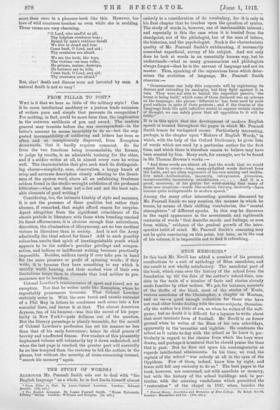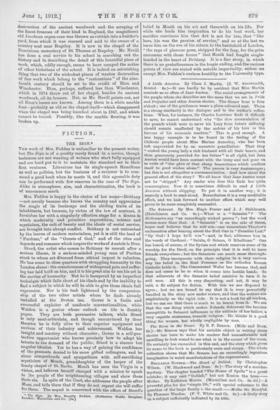ETON MEMORIES.* IN this book Mr. Nevill has added a
number of his personal recollections to a sort of anthology of Eton anecdotes, and the result is not wholly satisfactory. The anecdotal part of the book, which runs over the history of the school from the foundation up till the date of the author's school-time, con- sists in the main of a number of facts and stories already made familiar by other writers. We get, for instance, accounts of the thefts of the block, most of the stories of Keate, various anecdotes of the Christopher, a chapter on Montem, and so on—a good enough collection for those who have not read other books dealing with the same subjects. Occasion- ally the author is a little at sea, as when he writes of the wall- game; but no doubt it is difficult for a layman to write about that most intricate form of football. Mr. Nevill is on firmer ground when he writes of the Eton of his own sehooldaya, apparently in the 'seventies and 'eighties. He contrasts the school as it exists to-day with the school as he knew it, par- ticularly in regard to the classes from which the boys were drawn, and perhaps it is natural that he should praise the time that is past. But he does not spare his contemporaries as regards intellectual attainments. In his time, we read, the captain of the school " was nobody at all in the eyes of the Oppidans. Few of them, indeed, knew him by sight, and fewer still felt any curiosity to do so." The best pages in the book, however, are concerned, not with anecdote or memory, but with the history of the school buildings and, in par- ticular, with the amazing vandalisms which permitted the " restoration " of the chapel in 1847, when, besides the • Floreat Etona: Anecdotes and Memories of Eton College. By Ralph Nevill. London: Macmillan and Co. [15s. net.] destruction of the ancient woodwork and the scraping of the finest frescoes of their kind in England, the magnificent old Jacobean organ-case was thrown as rubbish into a builder's yard, from which it was rescued and sold to the owner of a country seat near Rugeley. It is now in the chapel of the Dominican monastery of St. Thomas at Rugeley. Mr. Nevill has done a real service to his school in searching out the history and in desCribing the detail of this beautiful piece of work, which, oddly enough, seems to have escaped the notice of other historians of the school. It is indeed an astonishing thing that two of the wickedest pieces of wanton destruction of fine work which belong to the " restorations " of the nine- teenth century should be set to the credit of Eton and Winchester. Eton, perhaps, suffered less than Winchester, which in 1874 threw out of her chapel, besides its ancient woodwork, all its brasses. But, as Mr. Nevill points out, not all Eton's losses are known. Among them is a white marble font—probably as old as the chapel itself—which disappeared when the chapel was being knocked about in 1847, and which cannot be traced. Possibly, like the marble flooring, it was broken up.







































 Previous page
Previous page